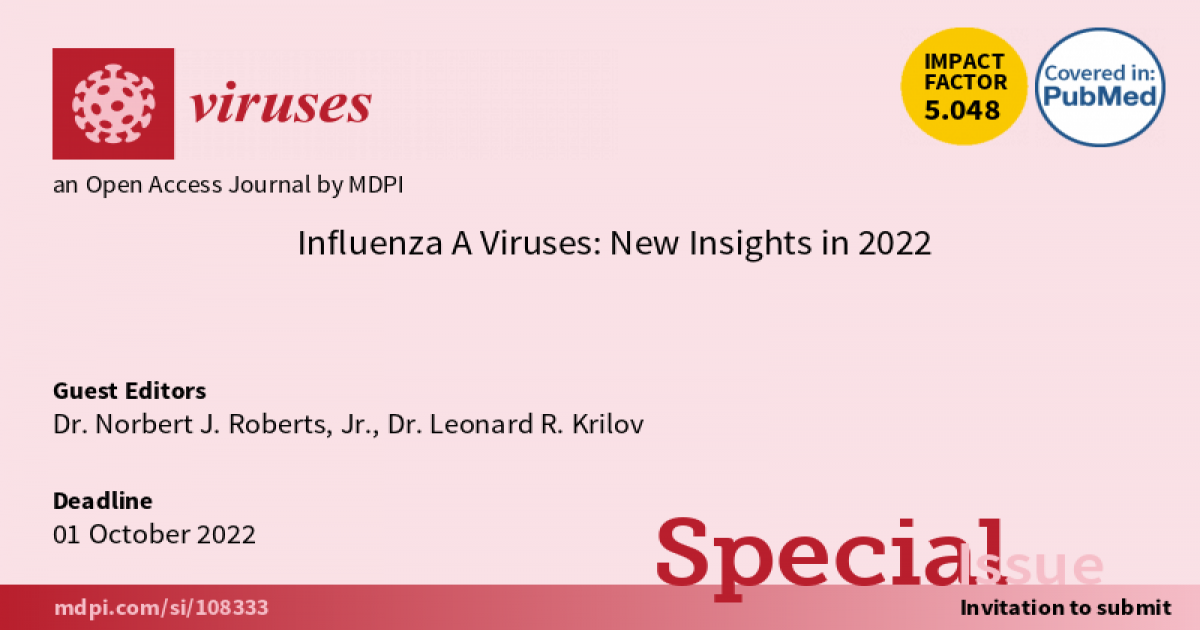Influenza A Viruses: New Insights in 2022
A special issue of Viruses (ISSN 1999-4915). This special issue belongs to the section "Animal Viruses".
Deadline for manuscript submissions: closed (1 October 2022) | Viewed by 17022

Special Issue Editors
Interests: influenza virus; respiratory syncytial virus; viral pathogenesis; monocytes; macrophages; lymphocytes
Special Issues, Collections and Topics in MDPI journals
Interests: respiratory syncytial virus; influenza virus; clinical trials; respiratory virus vaccines; RSV-related inflammation and immune responses
Special Issues, Collections and Topics in MDPI journals
Special Issue Information
Dear Colleagues,
Influenza A virus (IAV) is a major cause of respiratory infections worldwide, with the most severe cases occurring in the very young and in elderly individuals. Infants and children having their first encounter with the virus have the greatest incidence of severe enough infection to require medical attention. Although the highest illness rates occur in children, most deaths occur with infections of the elderly. In addition, immunocompromised individuals of any age are at greater risk of adverse outcomes.
Seasonal IAV was responsible for an average of 12,000–52,000 deaths annually between 2010 and 2020 in the U.S. before onset of the COVID-19 pandemic, according to the CDC, with preventive measures addressing the latter respiratory infection also reducing the impact of seasonal influenza. IAV pandemics emerge at unpredictable intervals. There have been four influenza pandemics in the last 103 years, with the 1918 H1N1 avian virus responsible for an estimated 675,000 U.S. deaths. Viral strains with pandemic potential continue to be isolated from avian species. For example, outbreaks of human infection by avian influenza A virus subtypes H5N1 and H7N9 have been associated with 53% and 39% mortality, respectively.
The aim of this Special Issue of Viruses is to contribute to the current knowledge regarding innate and adaptive immunity to IAV, the pathogenesis of the infection, the ecology of the infection, the populations at risk and epidemiology of the infection, treatment approaches directed at IAV or modification of host responses, and approaches to vaccine development that are likely to benefit the host upon subsequent natural challenge. Research articles, review articles, and short communications are invited. Reports of promising candidate "universal" (broadly protecting) IAV vaccines and reports of IAV co-infections (e.g., with SARS-CoV-2 which is currently producing a worldwide pandemic) are encouraged.
Dr. Norbert J. Roberts, Jr.
Dr. Leonard R. Krilov
Guest Editors
Manuscript Submission Information
Manuscripts should be submitted online at www.mdpi.com by registering and logging in to this website. Once you are registered, click here to go to the submission form. Manuscripts can be submitted until the deadline. All submissions that pass pre-check are peer-reviewed. Accepted papers will be published continuously in the journal (as soon as accepted) and will be listed together on the special issue website. Research articles, review articles as well as short communications are invited. For planned papers, a title and short abstract (about 250 words) can be sent to the Editorial Office for assessment.
Submitted manuscripts should not have been published previously, nor be under consideration for publication elsewhere (except conference proceedings papers). All manuscripts are thoroughly refereed through a single-blind peer-review process. A guide for authors and other relevant information for submission of manuscripts is available on the Instructions for Authors page. Viruses is an international peer-reviewed open access monthly journal published by MDPI.
Please visit the Instructions for Authors page before submitting a manuscript. The Article Processing Charge (APC) for publication in this open access journal is 2600 CHF (Swiss Francs). Submitted papers should be well formatted and use good English. Authors may use MDPI's English editing service prior to publication or during author revisions.
Keywords
- Influenza A virus (IAV)
- IAV pathogenesis
- Innate immunity to IAV
- Adaptive immunity to IAV
- IAV therapy
- IAV vaccines, including universal vaccines
- IAV epidemiology
- IAV co-infections
Benefits of Publishing in a Special Issue
- Ease of navigation: Grouping papers by topic helps scholars navigate broad scope journals more efficiently.
- Greater discoverability: Special Issues support the reach and impact of scientific research. Articles in Special Issues are more discoverable and cited more frequently.
- Expansion of research network: Special Issues facilitate connections among authors, fostering scientific collaborations.
- External promotion: Articles in Special Issues are often promoted through the journal's social media, increasing their visibility.
- Reprint: MDPI Books provides the opportunity to republish successful Special Issues in book format, both online and in print.
Further information on MDPI's Special Issue policies can be found here.






